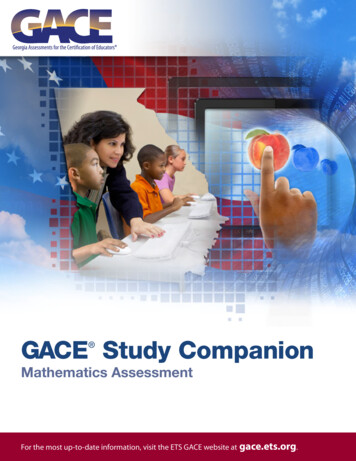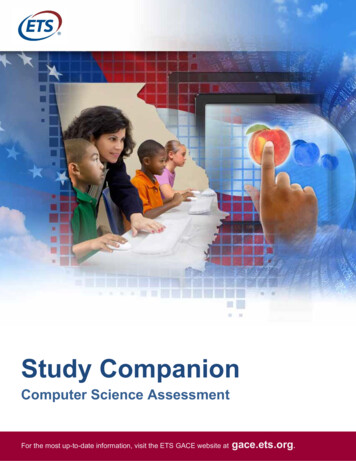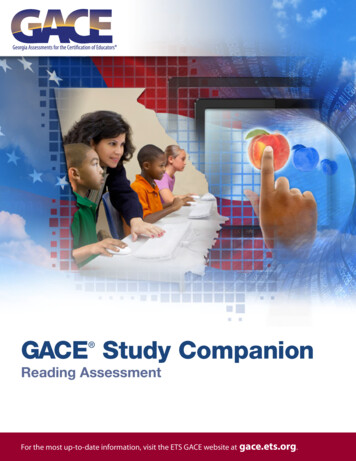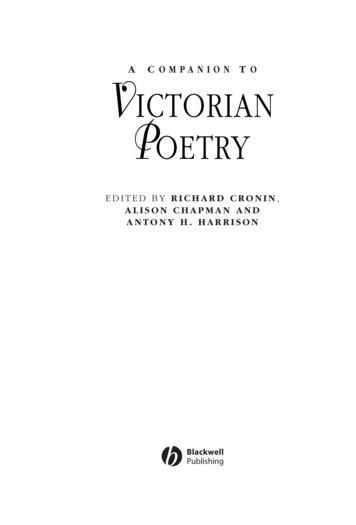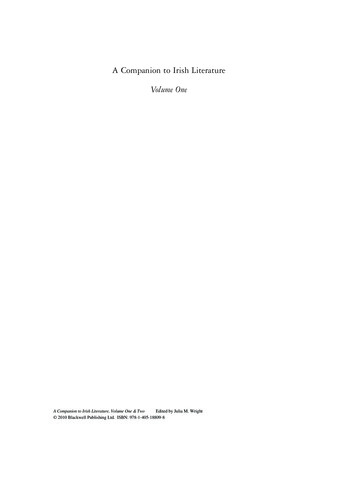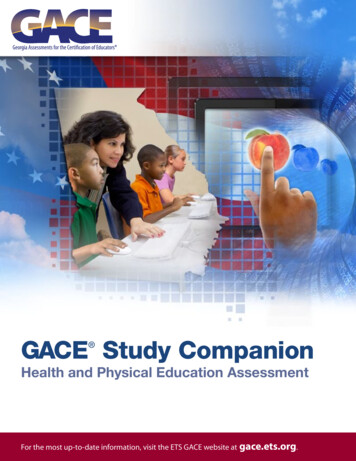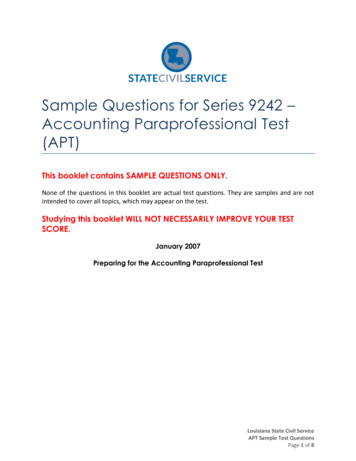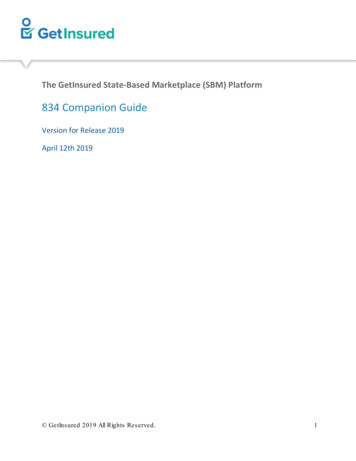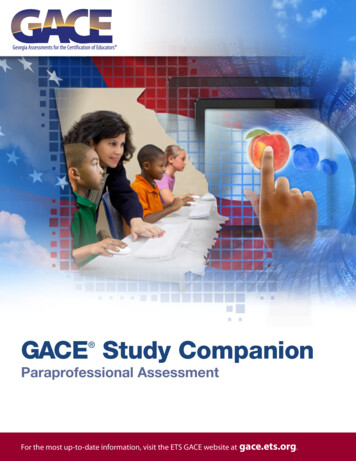
Transcription
GACE Study Companion Paraprofessional AssessmentFor the most up-to-date information, visit the ETS GACE website at gace.ets.org.
Last Updated: January 2016Copyright 2016 by Educational Testing Service. All rights reserved. ETS is a registeredtrademark of Educational Testing Service (ETS). Georgia Assessments for the Certification ofEducators, GACE, and the GACE logo are registered trademarks of the Georgia ProfessionalStandards Commission (GaPSC). All other trademarks are property of their respective owners.This publication has been produced for the GaPSC by ETS. ETS is under contract to theGaPSC to administer the Georgia Assessments for the Certification of Educators. TheGeorgia Assessments for the Certification of Educators are administered under the authorityof the GaPSC; regulations and standards governing the program are subject to change withoutnotice at the discretion of the GaPSC. The GaPSC and ETS are committed to preventingdiscrimination on the basis of race, color, national origin, sex, religion, age, or disability in theadministration of the testing program or the provision of related services.
Table of ContentsAbout the Assessment . 4Content Specifications . 4Test Subareas . 5Subarea I: Reading . 5Subarea II: Mathematics . 6Subarea III: Writing . 7Practice Questions . 9Reading .10Mathematics .14Writing .17Answer Key and Rationales .20Preparation Resources .27Guide to Taking a GACE Computer-delivered Assessment .27Reducing Test Anxiety.27Study Tips: Preparing for a GACE Assessment .27Journals.27Other Resources .27Online Resources .29Note: After clicking on a link, right click and select “Previous View” to go back to original text.GACE Paraprofessional Assessment Study Companion3
About the AssessmentAssessment NameParaprofessionalGrade LevelP–12Test Code177Testing Time2.5 hoursTest Duration3 hoursTest FormatComputer deliveredNumber of Selected-response Questions90Question FormatThe test consists of a variety of short-answerquestions such as selected-responsequestions, where you select one answerchoice or multiple answer choices (dependingon what the question asks for), questionswhere you enter your answer in a text box,and other types of questions. You can reviewthe possible question types in the Guide toTaking a GACE Computer-delivered Test.Number of Constructed-response Questions0The GACE Paraprofessional assessment is designed to measure the skills and knowledge ofprospective and practicing paraprofessionals in the state of Georgia in reading, mathematics,and writing, as well as the ability to apply those skills and knowledge to assist in classroominstruction.The testing time is the amount of time you will have to answer the questions on the test. Testduration includes time for tutorials and directional screens that may be included in the test.The questions in this assessment assess both basic knowledge across content areas and theability to apply principles.The total number of questions that are scored is typically smaller than the total number ofquestions on the test. Most tests that contain selected-response questions also includeembedded pretest questions, which are not used in calculating your score. By including pretestquestions in the assessment, ETS is able to analyze actual test-taker performance on proposednew questions and determine whether they should be included in future versions of the test.Content SpecificationsThis assessment is organized into content subareas. See a breakdown of the subareas for thisassessment on the following pages.Note: After clicking on a link, right click and select “Previous View” to go back to original text.GACE Paraprofessional Assessment Study Companion4
Test SubareasSubareaApprox. Percentageof TestI. Reading34%II. Mathematics33%III. Writing33%Subarea I: ReadingReading Skills and Knowledge questions measure the examinee’s ability to understand,interpret, and analyze a wide range of text. Questions are based on reading passages —as well as graphs, charts, and tables — drawn from a variety of subject areas and real-lifesituations.The questions assess the examinee’s ability to:A. Identify the main idea or primary purposeB. Identify supporting ideasC. Identify how a reading selection is organizedD. Determine the meanings of words or phrases in contextE. Draw inferences or implications from directly stated contentF. Determine whether information is presented as fact or opinionG. Interpret information from tables, diagrams, charts, and graphsReading Application questions are typically based on classroom scenarios in which students areinvolved in reading-related tasks, such as reading assigned passages, or working on vocabularydevelopment. Some questions concern foundations of reading: the knowledge and skillsstudents need when they are learning the basic features of words and written text.These questions assess the examinee’s ability to help students:A. Sound out words; e.g., recognize long and short vowels, consonant sounds, rhymesB. Break down words into parts; e.g., recognize syllables, root words, prefixes, suffixesC. Decode words or phrases using context cluesD. Distinguish between synonyms, antonyms, and homonymsE. Alphabetize wordsNote: After clicking on a link, right click and select “Previous View” to go back to original text.GACE Paraprofessional Assessment Study Companion5
Other questions are concerned with tools of the reading process: common strategies used inclassrooms before, during, and after reading to aid students’ reading skills.These questions assess the examinee’s ability to:A. Help students use prereading strategies, such as skimming or making predictionsB. Ask questions about a reading selection to help students understand the selectionC. Make accurate observations about students’ ability to understand and interpret textD. Help students use a dictionaryE. Interpret written directionsSubarea II: MathematicsThe Mathematics Skills and Knowledge questions assess the examinee’s knowledge ofmathematical concepts and ability to apply them to abstract and real-life situations. The testquestions do not require knowledge of advanced-level mathematics vocabulary. Examineesmay not use calculators.Three categories of math skills are tested:1. Number Sense and Basic AlgebraA. Perform basic addition, subtraction, multiplication, and division of whole numbers,fractions, and decimalsB. Recognize multiplication as repeated addition and division as repeated subtractionC. Recognize and interpret mathematical symbols such as , , , , D. Understand the definitions of basic terms such as sum, difference, product, quotient,numerator, and denominatorE. Recognize the position of numbers in relation to each other; e.g.,and12F. Recognize equivalent forms of a number; e.g.,11is between3412 1 ; 0.1 10%24 10G. Demonstrate knowledge of place value for whole numbers and decimal numbersH. Compute percentagesI.Demonstrate knowledge of basic concepts of exponents;e.g., 22 4, 24 2 x 2 x 2 x 2 16J. Demonstrate knowledge of “order of operations” (parentheses, exponents,multiplication, division, addition, subtraction)K. Use mental math to solve problems by estimationL. Solve word problemsNote: After clicking on a link, right click and select “Previous View” to go back to original text.GACE Paraprofessional Assessment Study Companion6
M. Solve one-step single-variable linear equations; e.g., find x if x 4 2N. Indentify what comes next in a sequence of numbers2. Geometry and MeasurementA. Represents time and money in more than one way; e.g., 30 minutes 10:15 quarter after 10; 0.50 50 cents half dollar1hour;2B. Convert between units or measures in the same system; e.g., inches to feet,centimeters to metersC. Identify basic geometrical shapes; e.g., isosceles triangle, right triangle, polygonD. Perform computations related to area, volume, and perimeter for basic shapesE. Graph data on an xy-coordinate plane3. Data AnalysisA. Interpret information from tables, charts, and graphsB. Given a table, chart, or graph with time-related data, interpret trends over timeC. Create basic tables, charts, and graphsD. Compute the mean, median, and modeThe Math Application questions assess the examinee’s ability to apply the three categories ofmath skills listed in Subarea III (Math Skills and Knowledge) in a classroom setting or in supportof classroom instruction. The questions focus on testing mathematical competencies needed toassist the teacher with instruction. The test questions do not require knowledge of advancedlevel mathematics vocabulary. Examinees may not use calculators.Subarea III: WritingWriting Skills and Knowledge questions assess the examinee’s ability to identify:A. Basic grammatical errors in standard written EnglishB. Errors in word usage; e.g., their/they’re/there, then/thanC. Errors in punctuationD. Parts of a sentence; e.g., subject and verb/predicateE. Parts of speech; e.g., nouns, verbs, pronouns, adjectives, adverbs, prepositionsF. Errors in spellingWriting Application questions are typically based on classroom scenarios in which students areplanning, composing, revising, or editing documents written for a variety of purposes. Somequestions are concerned with aspects of the writing process, the full range of activities usedwhen composing written documents.Note: After clicking on a link, right click and select “Previous View” to go back to original text.GACE Paraprofessional Assessment Study Companion7
These questions assess the examinee’s ability to help students:A. Use prewriting to generate and organize ideas (including freewriting and using outlines)B. Indentify and use appropriate reference materialsC. Draft and revise (including composing or refining a thesis statement, writing focused andorganized paragraphs, and writing a conclusion)D. Edit written documents for clarity, grammar, sentence integrity (run-ons and sentencefragments), word usage, punctuation, and spellingSome questions are concerned with writing applications, the application of writing for differentpurposes.These questions assess the examinee’s ability to help students:A. Write for different purposes and audiences (including using appropriate language andtaking a position for or against something)B. Recognize and write in different modes and forms; e.g., descriptive essays, persuasiveessays, narratives, lettersNote: After clicking on a link, right click and select “Previous View” to go back to original text.GACE Paraprofessional Assessment Study Companion8
Practice QuestionsThe practice questions in this study companion are designed to familiarize you with the typesof questions you may see on the assessment. While they illustrate some of the formats andtypes of questions you will see on the test, your performance on these sample questions shouldnot be viewed as a predictor of your performance on the actual test. Fundamentally, the mostimportant component in ensuring your success is familiarity with the content that is covered onthe assessment.To respond to a practice question, choose one of the answer options listed. Be sure to readthe directions carefully to ensure that you know what is required for each question. You may findit helpful to time yourself to simulate actual testing conditions. A correct answer and a rationalefor each sample test question are in the section following the practice questions.Keep in mind that the test you take at an actual administration will have different questions,although the proportion of questions in each subarea will be approximately the same. Youshould not expect the percentage of questions you answer correctly in these practice questionsto be exactly the same as when you take the test at an actual administration, since numerousfactors affect a person’s performance in any given testing situation.Note: After clicking on a link, right click and select “Previous View” to go back to original text.GACE Paraprofessional Assessment Study Companion9
ReadingDirections: Each of the questions or incomplete statements below is followed by four suggestedanswers or completions. Select the one that is best in each case.Questions 1-2 are based on the following passage:Early scientists believed that all dinosaurs, like most reptiles, laid and then immediatelyabandoned their eggs. The newly hatched young were left to take care of themselves. However,the recent discovery of a group of nests has challenged this belief. The nests, which containedfossilized baby dinosaurs that were not newborn, provided evidence that dinosaur parentsactually cared for their young. For some time after birth, the babies would stay at the nest whilethe parents brought back plant matter for food. The young stayed at home until they were largeenough to roam safely on their own.1.The passage is primarily concerned withA.B.C.D.contrasting dinosaurs with modern reptiles.explaining why dinosaurs became extinct.discussing recent findings about dinosaurs’ behavior.providing new information about what dinosaurs ate.Answer and Rationale2.The discovery of a group of dinosaur nests challenged the idea that dinosaursA.B.C.D.fed their young with plant matter.hatched few eggs.migrated in search of food.deserted their young.Answer and RationaleNote: After clicking on a link, right click and select “Previous View” to go back to original text.GACE Paraprofessional Assessment Study Companion10
3.What conclusion can be drawn from the data presented in the graph above?A. Japanese American businesses were more successful in California than in other statesin 1909.B. The number of Japanese American businesses in Los Angeles and San Franciscoincreased greatly from 1900 to 1909.C. In 1909 there were more Japanese American businesses in Los Angeles than there werein San Francisco.D. In 1909 most Japanese American businesses in Los Angeles and San Francisco werelarge companies.Answer and RationaleNote: After clicking on a link, right click and select “Previous View” to go back to original text.GACE Paraprofessional Assessment Study Companion11
4.American science-fiction writers produce a large number of novels for young people thesedays, yet few take advantage of the latitude allowed by the genre. Since the 1970s, youngadult science fiction has had little to do with the wonders of science, intergalactic travel, ornew worlds in space. Most of the novels are cautionary tales about regimented, conformistsocieties or about the social order collapsed into barbarism. This change has resulted inscience fiction that is, to me as a reader, much less interesting than science fiction usedto be.Which sentence from the passage is most clearly an expression of opinion rather than astatement of fact?A.B.C.D.“American science-fiction . . . the genre.”“Since the . . . in space.”“Most of . . . into barbarism.”“This change . . . to be.”Answer and RationaleNote: After clicking on a link, right click and select “Previous View” to go back to original text.GACE Paraprofessional Assessment Study Companion12
Questions 5-6 are based on the following passage, which students are reading insmall groups.The environment in which people live often determines the kind of technology they use. Forinstance, ancient Mesopotamia had few plants suitable for making paper. But the area hadlots of high-quality clay. People used the clay to store information.Modern people store information on paper, computer disks, and CDs. Mesopotamians storedtheir data on clay tablets — pieces of smooth clay small enough to fit into the palm of anadult’s hand. When a clay tablet was damp, people could scratch pictures and letters into itssurface using a sharpened reed. When dried in the hot sun, the clay hardened, preserving thewriting and the information.5.The teacher wants students to understand why the Mesopotamians wrote on clay. Whatquestion could a paraprofessional ask a group of students about the passage that would besthelp the students understand why the Mesopotamians wrote on clay?A.B.C.D.Why did the Mesopotamians make clay tablets small enough to fit in the hand?What kinds of pictures and letters did the Mesopotamians scratch on clay?Why didn’t the Mesopotamians write on paper the way we do today?How did the Mesopotamians learn to read and write?Answer and Rationale6.The paraprofessional asks a group of students to describe the main purpose of the secondparagraph. Which of the following four responses from the students is most accurate?AB.C.D.To explain how the Mesopotamians used clay to store informationTo describe the different ways we store information todayTo explain why the environment affects the kind of technology people useTo show that Mesopotamians made small clay tablets so they could carry them easilyAnswer and RationaleNote: After clicking on a link, right click and select “Previous View” to go back to original text.GACE Paraprofessional Assessment Study Companion13
MathematicsDirections: Each of the questions or incomplete statements below is followed by four suggestedanswers or completions. Select the one that is best in each case.7.In the graph above, how many more votes were received for the park than the mall as anactivity for a class trip?A. 1B. 2C. 6D. 14Answer and Rationale8.What digit is in the hundredths place of the number 5,123.6487?A.B.C.D.1468Answer and RationaleNote: After clicking on a link, right click and select “Previous View” to go back to original text.GACE Paraprofessional Assessment Study Companion14
9.445.76 9.634 is approximately equal toA.46B.446C. 4,460D. 44,600Answer and Rationale10. Which of the following is NOT a point on line ℓ shown on the graph above?A.B.C.D.(0, 3)(1, 3)(3, 0)(3, 3)Answer and RationaleNote: After clicking on a link, right click and select “Previous View” to go back to original text.GACE Paraprofessional Assessment Study Companion15
5 3 8 9 ?11. A student wrote the incorrect number sentence above to solve the following problem:“Multiply the sum of 5 and 3 and the sum of 8 and 9.”To correct the error, the student’s number sentence should be changed toA.B.C.D.(5 3) 8 9 ?5 3 (8 9) ?(5 3 8) 9 ?(5 3) (8 9) ?Answer and Rationale12. A paraprofessional is helping a student find the equation for the area of parallelogramABCD shown above by pointing out to the student that the parallelogram can be divided intotwo congruent triangles. The area of the parallelogram is then the sum of the areas of thetwo triangles. Which of the following is the correct expression to use to find the area ofparallelogram ABCD ?11(7 4) (7 4)2211B.(7 5) (7 5)22C. (7 5) (7 4)D. (7 4) 5A.Answer and RationaleNote: After clicking on a link, right click and select “Previous View” to go back to original text.GACE Paraprofessional Assessment Study Companion16
WritingDirections for Questions 13 and 14In each of the sentences below, four portions are underlined. One of these contains a grammaticalconstruction, a word use, or an instance of punctuation that would be inappropriate in carefully writtenEnglish. Select the corresponding answer option for the portion that is inappropriate. No sentence hasmore than one error.13. The role of technology in the nation’s public schools have been increasing steadily for morethan 20 years.A.B.C.D.nation’shavesteadilythanAnswer and Rationale14. Jupiter, the largest planet in the solar system, spins very rapidly on it’s axis, with the resultthat a day on Jupiter lasts only 9 hours and 55 minutes.A.B.C.D.largestrapidlyit’slastsAnswer and RationaleNote: After clicking on a link, right click and select “Previous View” to go back to original text.GACE Paraprofessional Assessment Study Companion17
15. Because there were no refrigerators on the United States space shuttles, all of the food eatenby the astronauts had to be in a nonperishable form.In the sentence above, the underlined word is being used asA.B.C.D.a noun.a verb.an adjective.an adverb.Answer and Rationale16. Which word is not spelled correctly?A.B.C.D.CompairHardwareRepairScareAnswer and RationaleNote: After clicking on a link, right click and select “Previous View” to go back to original text.GACE Paraprofessional Assessment Study Companion18
Questions 17–18 are based on the following rough draft written by a student.How to Teach Your Dog to Sitby Kiara(1) First hold a dog biscuit so the dog pays attention. (2) Say “Sit!” (3) When you say it, use aloud and firm voice. (4) Move the hand holding the biscuit over the dog’s nose, don’t let himgrab it. (5) You may have to give a light backwards tug on the dog’s leash. (6) When the dog sitsdown, give him the treat and lots of praise. (7) Repeat this a few times, and he’ll probablyunderstand the command.17. Kiara is writing an introductory sentence that summarizes the main points of the paragraph.What sentence would be the strongest introductory sentence for the paragraph?A.B.C.D.Dogs are naturally very intelligent and obedient.Your dog probably likes some dog biscuits better than others.It is easy to teach your dog the command “Sit!”Nobody likes a dog that can’t play catch.Answer and Rationale18. Kiara is learning how to use transition words (words that clarify the relationships betweenideas). What transition word or words should Kiara use before the word “don’t” in sentence4 in order to clarify the meaning of the sentence?A.B.C.D.butbecausefor examplesoAnswer and RationaleNote: After clicking on a link, right click and select “Previous View” to go back to original text.GACE Paraprofessional Assessment Study Companion19
Answer Key and tion C is correct. The passage notes the “recent discoveryof a group of nests” and then elaborates on what the discoveryreveals about the behavior of dinosaurs toward their young.Back to Question2DOption D is correct. The belief challenged by the discovery ofthe group of nests is that dinosaurs “abandoned their eggs” andleft their young to provide for themselves.Back to Question3BOption B is correct. Options A and D are incorrect becausethe graph does not offer information about Japanese Americanbusinesses in cities outside of California, nor does it offerinformation about the size of Japanese American businesses inLos Angeles and San Francisco. Option C is incorrect becausethe graph indicates that in 1909 there were fewer JapaneseAmerican businesses in Los Angeles than in San Francisco.Back to QuestionNote: After clicking on a link, right click and select “Previous View” to go back to original text.GACE Paraprofessional Assessment Study Companion20
QuestionNumberCorrectAnswer4DRationaleOption D is correct. The sentences referred to in options A,B, and C present facts about the number and subject matterof science fiction novels published today. In the last sentence,however, the author shifts to offering a personal opinion aboutscience fiction today; i.e., it’s not as interesting as it used to be.Back to Question5COption C is correct. The question would encourage students tothink about why the Mesopotamians did not have paper (they didnot have many of the proper plants) and help the students betterunderstand how the resources available to the Mesopotamianshelped determine the materials they used for writing.Back to Question6AOption A is correct. The second paragraph is primarilyconcerned with describing the processes used by theMesopotamians to write on clay tablets.Back to QuestionNote: After clicking on a link, right click and select “Previous View” to go back to original text.GACE Paraprofessional Assessment Study Companion21
QuestionNumberCorrectAnswer7BRationaleAccording to the graph, 8 votes were received for the park asan activity for a class trip and 6 votes were received for the mall.To determine how many more votes were received for the parkthan the mall, subtract the number of votes for the mall from thenumber of votes for the park.8 6 2Thus, 2 more votes were received for the park than the mall.The correct answer is option B.Back to Question8BThe hundredths place of 5,123.6487 is 2 digits to the right of thedecimal point as shown:decimal point 5,123.6487 hundredths placeThe digit in the hundredths place of the number is 4. The correctanswer is option B.Back to QuestionNote: After clicking on a link, right click and select “Previous View” to go back to original text.GACE Paraprofessional Assessment Study Companion22
QuestionNumberCorrectAnswer9CRationaleTo determine the approximate value of 445.76 9.634, round445.76 to 446 and round 9.634 to 10. Then multiply 446 and 10.446 10 4,460The approximate value is 4,460. The correct answer isoption C.Back to Question10CTo determine which point is not on the line l, plot the points inoptions A through D on the graph.As can be seen on the graph, the point C (3, 0) is not on line l.The correct answer is option C.Back to QuestionNote: After clicking on a link, right click and select “Previous View” to go back to original text.GACE Paraprofessional Assessment Study Companion23
QuestionNumberCorrectAnswer11DRationaleThe student’s number sentence5 3 8 9 ?is incorrect because according to the order of operations,multiplication precedes addition; thus 3 and 8 would be multipliedfirst, then 5 and then 9 would be added to the product. In order forthe sum of 5 and 3 and the sum of 8 and 9 to be calculated beforemultiplying, parentheses must be placed around 5 3 and 8 9.Thus the correct number sentence is:(5 3) (8 9) ?The correct answer is option D.Back to Question12AThe figure shown is a parallelogram. Parallelogram ABCD can bedivided into two congruent triangles, ABD and BCD, as shown bythe dotted line. Each triangle has an area of1bh, where b is the2length of the base, and h is the height of the triangle. The heightof a triangle is the line segment that is perpendicular to the base.In the figure, the base b of each triangle has length 7 and theheight h of each triangle is 4, and the area of each triangle is thus,A 1(7 4).2The area of parallelogram is the sum of the areas of the twotriangles, thus the area of parallelogram ABCD is11(7 4) (7 4).22The correct answer is option A.Back to QuestionNote: After clicking on a link, right click and select “Previous View” to go back to original text.GACE Paraprofessional Assessment Study Companion24
QuestionNumberCorrectAnswer13BRationaleThe error in the sentence occurs at option B. The subject ofthe verb “have been increasing” is the “role of technology”;because “role” is a singular noun, the verb should also besingular; i.e., “has been increasing.”Back to Question14CThe error in the sentence occurs at option C. As presentedin option C, the word “it’s” is an error in usage. When used inthe possessive form (the axis belongs to Jupiter), there is noapostrophe in the word “its.” There is an apostrophe in “it’s” onlywhen the word is being used as a contraction of “it is.”Back to Question15CThe correct answer is option C. An adjective is a word thatmodifies a noun or pronoun, usually by describing, identifying, orquantifying. Here, “nonperishable” modifies “form” by describingthe form of food eaten by the astronauts.Back to QuestionNote: After clicking on a link, right click and select “Previous View” to go back to original text.GACE Paraprofessional Assessment Study Companion25
QuestionNumberCorrectAnswer16ARationaleOption A is correct. The correct spelling is “compare.”Back to Question17CThe correct answer is option C. Kiara’s paragraph is concernedwith discussing what steps to take when teaching a dog to sit.Option A is too general; option B concerns a minor element of theparagraph, not its primary focus; and option D concerns playingcatch, which is not discussed in the paragraph at all.Back to Question18AThe correct answer is option A. The word “but” is used toemphasize the contrast expressed in the sentence: “Move thehand holding the biscuit over the dog’s nose, but don’t let himgrab it.”Back to QuestionNote: After clicking on a link, righ
math skills listed in SubareaIII (Math Skills and Knowledge) in a classroom setting or in support of classroom instruction. The questions focus on testing mathematical competencies needed to assist the teacher with instruction. The test questions do not require knowledge of advanced-level mathematics vocabulary. Examinees may not use calculators.
